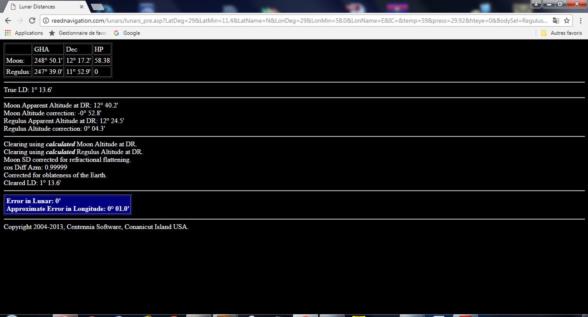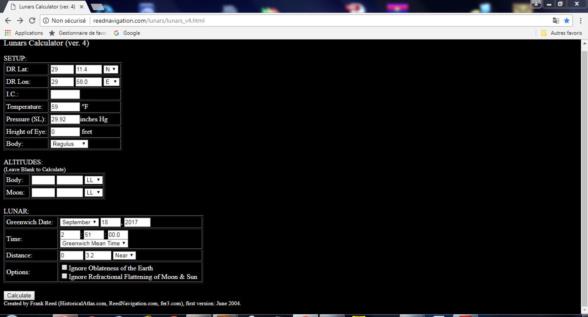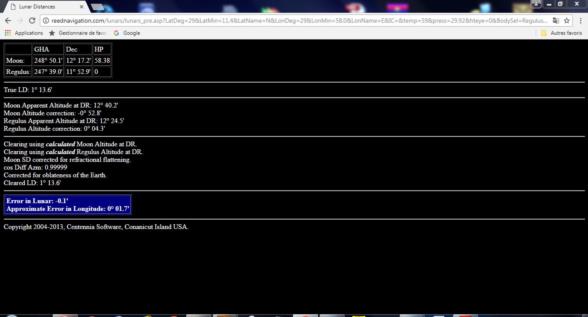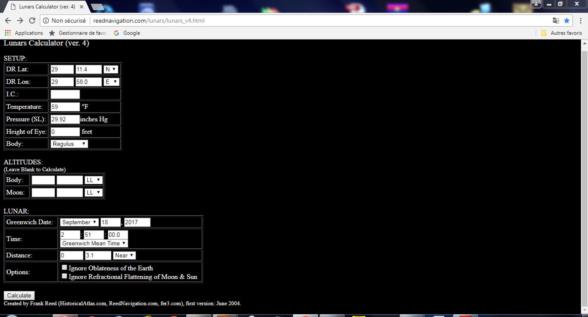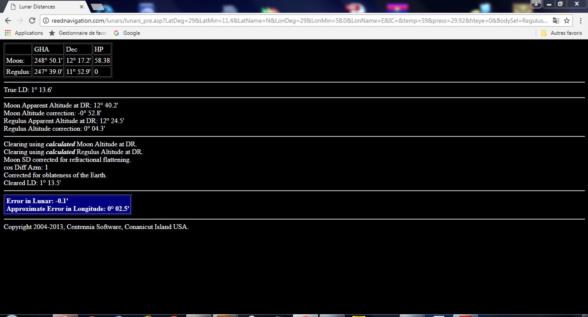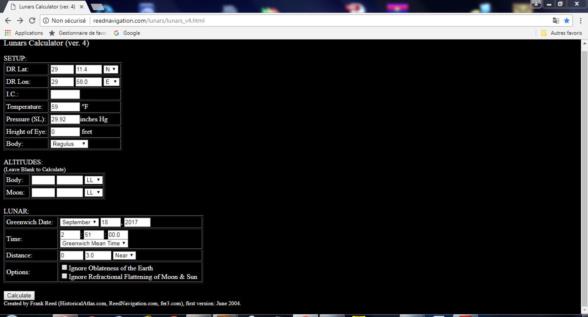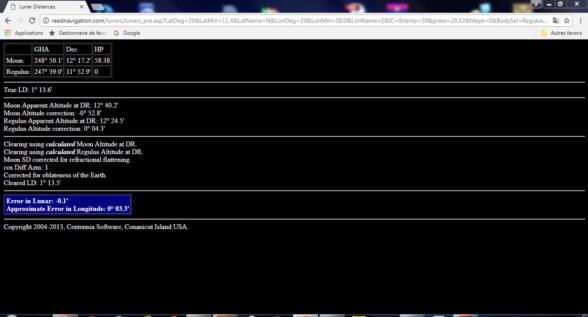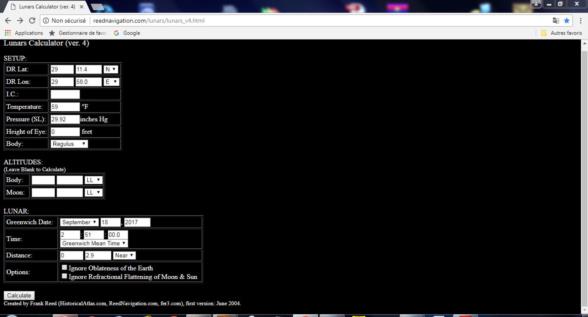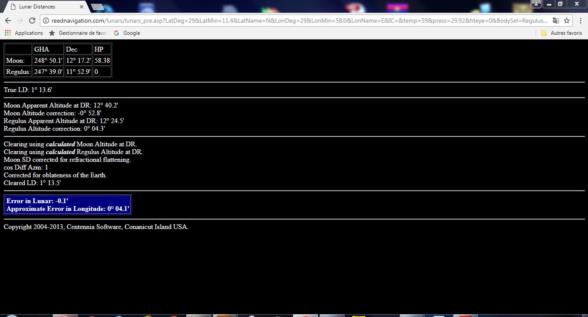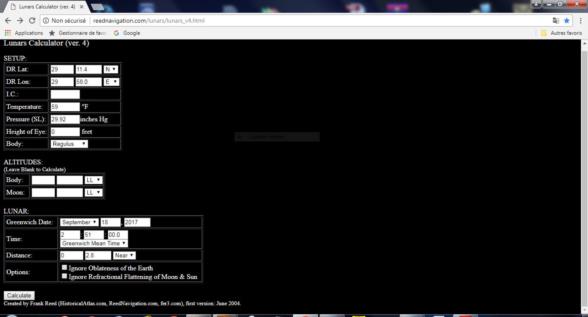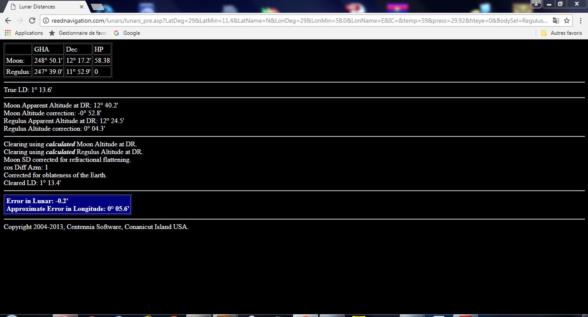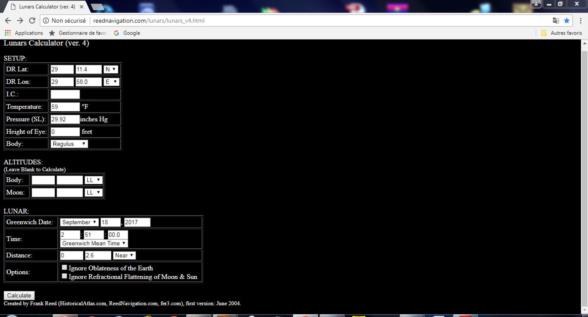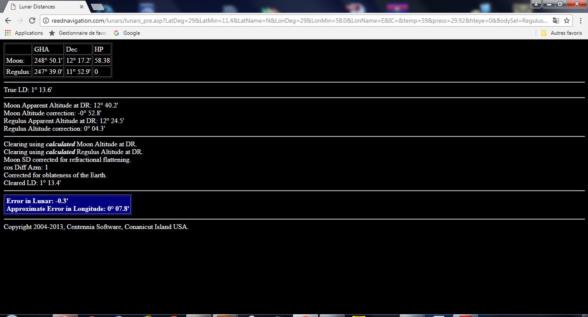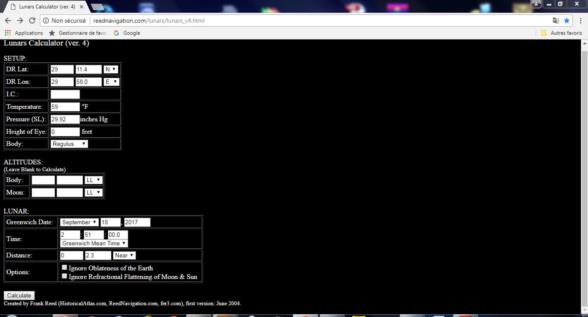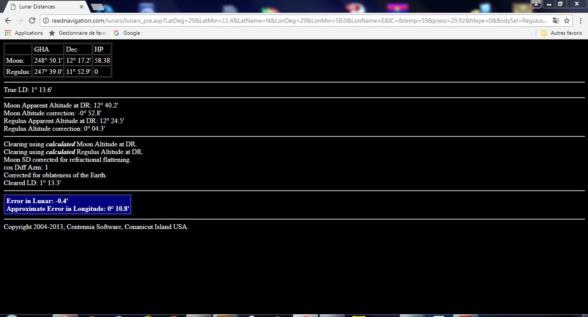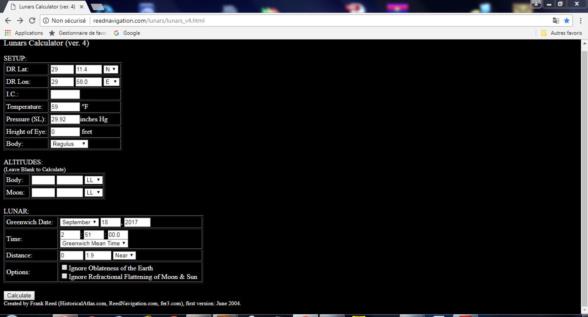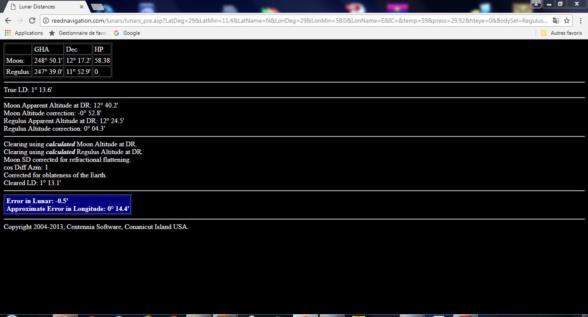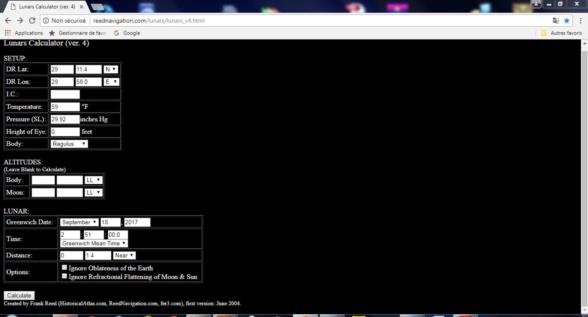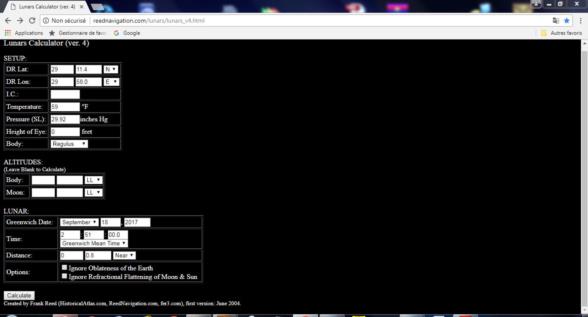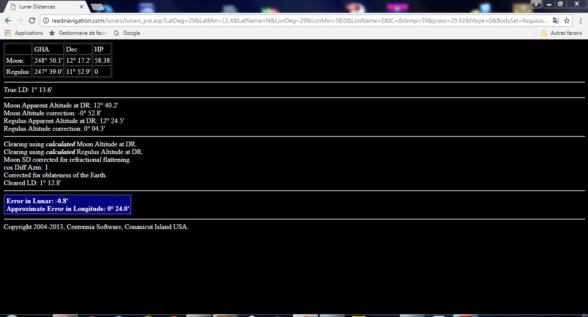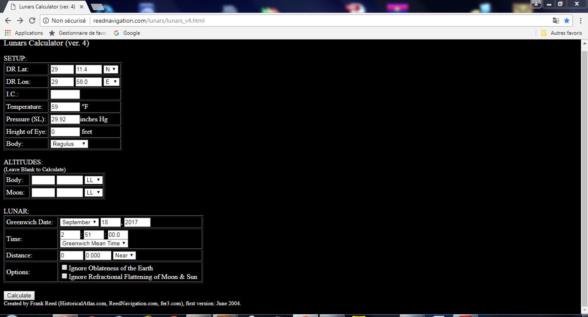
NavList:
A Community Devoted to the Preservation and Practice of Celestial Navigation and Other Methods of Traditional Wayfinding
From: Antoine Couëtte
Date: 2017 Sep 29, 05:38 -0700
RE : https://NavList.net/m2.aspx/Occultation-seen-from-Flight-level-410-Rudzinski-sep-2017-g40086
Dear Greg,
Dear Frank,
Greg, you recently stated in the post referenced here-above " A good eye you have Antoine ! The 0° lunar distance for Moon near limb with Regulus works out to -0.7' error. "
Well, I am not so sure whether my eyesight was so good actually then.
When reworking such " 0°00'0 distance Regulus Lunar ", my own results indicated that my eyesight so-deemed "0° distance" was actually some 3.0' !!!!! off.
Such 3' error can reasonably be explained since Regulus was very faint in the morning light and Lady Moon's lower limb was extremely bright in comparison. So, quite understandable that - after a long and tiring night flight and with my eyes starting to be dazzled by the increasing daylight I lost Regulus next to the bright limb before it actually got occulted. Another point here was our amazing apparent closure rate between both bodies - almost real time visible to the naked eye - because our eastern ground speed exceeded 450 knots - i.e. 10 ' or so of eastwards Longitude change each minute of time - , and my GPS time check was only accurate to 1 Minute of time. Nothing to worry about actually, but ...
... nonetheless, I was still left with a huge discrepancy between the results of the NavList web based Lunar application ( https://reednavigation.com/lunars/lunars_v4.html ) and my own results. I have kept claiming 0.1' accuracy on all my Lunars, and - as I understand - this web base application has also been described as being 0.1 ' accurate.
No way then to reconcile results which kept differing by about 20 times their claimed accuracies.
While both values indicated that Regulus was not occulted by the Moon yet, was its actual distance to the Moon Limb 3.0' or rather 0.7' ?
In order to make this example easy to work through all other popular Lunar Distance programs (e.g. from Paul Hirose, Peter Hakel, Andrés Ruiz), let's assume that the Observer is at Sea level,
18 sep 2017
TT-UT=+70,4 s : although this value is not displayed to the Users here - which is a bit unfortunate because we are dealing with fast moving Moon here, and because it also prevents from super accurately checking other independent software - the actual value used by the NavList web based application is likely quite close from +70.4 s.
UTC = 2h51m00.0s, N29°11'4 , E 029°58'0, height of Eye 0 , Observer's Altitude 0 , Temperature 59°F (15° C) and Sea level / Observer's Pressure 29.92" (1013.25 hPa)
I have therefore run the NavList web based Lunar application ( https://reednavigation.com/lunars/lunars_v4.html ) through successive iterations as follows :
1 - From Distance = 0.0', (image 1a) get (image 2b) : Error in Lunar = -0.8' . Let us remove such error from our previous data,
2 - From Distance = 0.0' +0.8' = 0.8' (image 2a) get (image 2b) : Error in Lunar = -0.6' . Let's keep doing the same as above, and so on ...
3 - From Distance = 0.8' + 0.6' = 1.4' (image 3a) get (image 3b) : Error in Lunar = -0.5'
4 - From Distance = 1.4' + 0.5' = 1.9' (image 4a) get (image 4b) : Error in Lunar = -0.4'
5 - From Distance = 1.9' + 0.4' = 2.3' (image 5a) get (image 5b) : Error in Lunar = -0.3'
6 - From Distance = 2.3' + 0.3' = 2.6' (image 6a) get (image 6b) : Error in Lunar = -0.2'
7 - From Distance = 2.6' + 0.2' = 2.8 (image 7a) get (image 7b) : Error in Lunar = - 0.1'
8 - From Distance = 2.8' + 0.1' = 2.9' (image 8a) get (image 8b) : Error in Lunar = -0.1'
9 - From Distance = 2.9' + 0.1' = 3.0' (image 9a) get (image 9b) : Error in Lunar = -0.1'
10 - From Distance = 3.0' + 0.1' = 3.1' (image 10a) get (image 10b) : Error in Lunar = -0.1'
11 - From Distance = 3.1' + 0.1' = 3.2' (image 11a) get (image 11b) : Error in Lunar = -0.0' Approximate Error in Longitude 0.1' (which is indicating us that the actual Error in Lunar is 2", adequately rounded off to 0.0' here)
I then ended up checking my own end results : i.e. the Actual Observed Sextant Distance computed to be 3.037' (Antoine's results a).
The NavList Computer rated it as (Antoine's results b) :
Error in Lunar = -0.1' , Approximate Error in Longitude = 0.2', which is indicating that our results differ from 4", which definitely falls inside the claimed accuracy range.
Here we are, both results now fully agree !
Conclusion : I had long observed that for Occultations, there are cases when the NavList Web based Lunar application results are not reliable at all, especially for grazing occultations. This case is simply catching me totally by surprise since it is definitely not a grazing occultation at all.
In order to easily correct for it, simply implement iterations - as here above - until 2 successive values become identical to less than a predefined value, e.g. 3 arc seconds. We would then keep enjoying enjoy an even more reliable web based tool which would then be now-on a battle-tested system usseful not only for general cases of Lunars, but also for Occultations.
Hint ! Nonetheless, grazing occultations are likely to remain extremely difficult to solve through such iteration method. This field remains unexplored - at least by me - as regards this web based tool and it is still worth trying.
Then, Frank - and unless you want to publish the required caveat about the existing version ver.4 Lunar distances to be restricted to a minimum of 5° to 7° earlier adressed a few years ago (a distance beyond which non-linear effects due to the circular shape of the Moon Limb become almost negligible for our precision) - ready to improve ver.4 into ver.5 ? :-)
Obviously, any and all comments from Inventors / Users of other independently developed Lunar Software (Paul, Andrés, Peter ... ) are most welcome.
Best Regards to all,
Kermit
